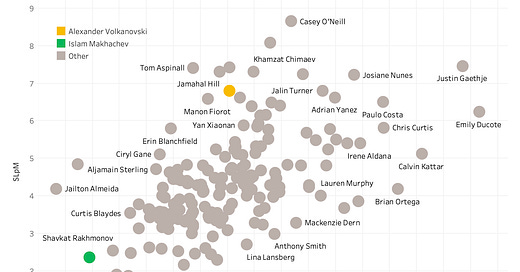Islam Makhachev and Alexander Volkanovski both made the top of the pound-for-pound list with very different styles. Which one will lead to a victory at UFC 284?
In the main event of UFC 284, lightweight champion Islam Makhachev puts his title on the line against featherweight champion Alexander Volkanovski. The fight is being billed as a battle between the top two ranked fighters in the UFC’s pound-for-pound rankings, and it appears to have the potential for a very interesting clash of styles.
Makhachev has gone on quite the run since joining the UFC in 2015. He has won 12 of his first 13 fights and captured the title from Charles Oliveira in his last fight at UFC 280. Arguably the most impressive aspect of his run has been his ability to win fights without absorbing damage. Through his 12 UFC fights, Makhachev has allowed his opponents to average only 0.95 significant strikes per minute. Of all the currently ranked UFC fighters, there are only two with better strike absorption rates, and they are both early in their UFC runs: Umar Numagomedov (0.73) and Jailton Almeida (0.34).
Offensively Makhachev has only landed 2.37 significant strikes per minute, which is the sixth lowest offensive output among ranked fighters. However, thanks to his outlier defense, he has a very respectable +1.42 striking differential. The current average for a ranked UFC fighter is +0.86.
These striking numbers stand in contrast with Volkanovski who is much more of an offensive dynamo. He has landed 6.79 significant strikes per minute, which ranks 11th amongst ranked fighters. Despite having faced Max Holloway multiple times, he has allowed only 3.53 significant strikes in his career. This leaves him with a +3.26 differential, which also is the 11th best measure among ranked fighters.
While Makhachev’s striking defense on the feet is solid, it is his ability to take fights to the floor and dominate via position that really is the key element of his impressive strike absorption numbers. In the UFC, he has averaged 3.42 takedowns per 15 minutes of fight time, which is well above the average for a ranked fighter (1.64).
Makhachev not only scores takedowns, but he also controls his opponents on the ground and along the cage. He has held control positions for 53% of his time in the cage. There are only seven fighters who have a large proportion of control time. Makhachev has had a control position for at least 31% of his cage time in 11 of his 13 fights. The only two where he did not establish position were finished in under two minutes.
These numbers appear to set up a rather obvious dynamic in the fight. If Volkanovski can keep the fight standing and at range, he should have the advantage. If Makhachev can consistently get to his wrestling, he should be able to defend his belt.
Volkanovski has successfully avoided 73% of the takedown attempts he has faced, and he has allowed his opponents to average only 0.59 takedowns per 15 minutes. Perhaps more importantly, he has been held in control positions for only 2.88% of his time in the cage.
In his last seven fights, he has only allowed takedowns against Brian Ortega (two) and Chad Mendes (three). While both were able to wrestle him to the ground multiple times, they were only able to register a combined 99 seconds of control time. Volkanovski has not allowed an opponent to accumulate over a minute of control time since his UFC debut against Yusuke Kasuya in 2016. Keep in mind the fact that his last five fights have been scheduled for five rounds and all went at least 20 minutes.
It remains to be seen how Makhachev will perform against a high level fighter if forced to engage in a distance striking contest for extended periods. His lone UFC defeat is probably not very encouraging for his supporters.
In 2015, Adriano Martins dropped and stopped the current lightweight champion in under two minutes after landing only three significant strikes. In the rest of his UFC run combined, Martins landed 100 significant strikes and scored only one other knockdown. Volkanovski averages only 0.37 knockdowns per 15 minutes and has scored only one knockdown in his last six fights (against Chan Sung Jung). If Makhachev’s struggle against Martins was a sign of a suspect chin and not a developing fighter early in his UFC run, Volkanovski’s power could be a concern.
Size is always a potential wildcard when fighters compete outside of their regular weight class. Per UFC Stats, Volkanovski will actually have a one-inch reach advantage, but he will also be four inches shorter. In theory, a physical size advantage would favor the fighter who chooses to grapple, but that has not always been the case in the history of the sport.
Despite doing his best work from the top position, Makhachev has been a finisher recently. Instead of grinding out decisions, he has won his last five fights via stoppage. This finishing ability is probably vital in a fight against Volkanovski. Holding down a dynamic fighter like the featherweight champion for the majority of a 25-minute fight can be exceedingly difficult. If he can’t make the most of his time on top, the fight would seem to favor Volkanovski.







Great article, super insightful! In light of the size (and walking weight) difference I have a hard time seeing Volkanovski being able to edge this one out, but it should be interesting.